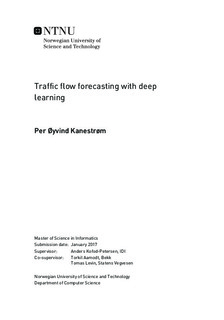Traffic flow forecasting with deep learning
Master thesis
Permanent lenke
http://hdl.handle.net/11250/2445851Utgivelsesdato
2017Metadata
Vis full innførselSamlinger
Sammendrag
In recent years there has been a vast increase in available data with the ad-vancement of smart cities. In the domain of Intelligent Transportation Systems(ITS) this modernisation can positively effect transportation networks, thus cut-ting down travel time, increase efficacy, and reduce environmental impact fromvehicles.Norwegian Public Roads Administration (NPRA) is currently deploying a newvehicle detector system named Datainn on all public roads in Norway. Datainnsends metadata on all detected vehicles in real time. This includes informationabout speed, gap between vehicles, weight, and classification of vehicle type.Many machine learning approaches has been researched in literature on howto forecast traffic flow information. One such approach is that of using ArtificialNeural Networks (ANNs). In this research ANN based methods have been explored.This was done by first performing a state-of-the-art Structured Literature Review(SLR) on ANN methods in literature.From the review, Stacked Sparse Autoencoder (SSAE) model was comparedwith recent advances of Long Short-Term Memory (LSTM) and Deep NeuralNetwork (DNN) on four different prediction horizons. The data foundation wasthe new Datainn system using traffic data from a highway around Norway scapitol, Oslo. Further, the model performance was assessed with extended featurevectors including more metadata from Datainn.The results found that the LSTM model always outperformed DNN and SSAE,although in general the performance characteristics was somewhat similar. Ex-tending the feature vector with more variables had a negative effect on DNN,while resulting in better performance for Recurrent Neural Network (RNN) onlong-term (60 minute) forecasting horizons. For SSAE it had a slight positiveeffect, but not enough get better results than RNN or DNN.
